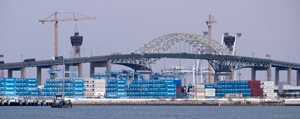The twin ports of Long Beach and of Los Angeles saw increased cargo traffic in March. The Port of Long Beach saw a 20 percent increase in its cargo numbers compared to a year ago and posted its best quarter since 2007. The Los Angeles port saw a whopping 29 percent jump in incoming cargo containers compared to the year earlier.
Los Angeles saw 788,524 20-foot equivalent units (TEUs) moved, compared to 612,863 at the same time last year. Of those, 373,549 TEUs came into the port and 191,772 were exported. Another 223,203 empty containers were shipped out, an increase of 37 percent.
In Long Beach, exports decreased 5.3 percent to 120,435 TEUs. Empties numbered 135,413, up 4.2 percent. In total, container movement increased 8.7 percent to 505,382 TEUs last month.
“We see a lot of upside for the remainder of 2017 as we expand our partnership with the world’s second-largest line, Mediterranean Shipping Co., add new business, and strengthen our relationships with our partners,” Long Beach Harbor Commission President Lori Ann Guzmán, said in a statement.
Port officials at Los Angeles, which saw better export numbers than Long Beach, said that the higher numbers were due to a combination of strong export volumes (up 20 percent), a post-Lunar New Year surge of cargo from Asia, and U.S. retailers shipping merchandise ahead of the new vessel alliance deployments that began this month.
Three new shipping alliances launched on April 1 as a response to the shipping industry’s struggles in recent years. Alliances will allow carriers to share space on vessels as a way to address overcapacity and cut costs. They are expected to account for 96 percent of container trade between Asian and West Coast ports and for 77 percent of global container capacity, according to the Port of Long Beach.
The two ports together handle more than 15 million cargo containers accounting for $450 billion in trade.
Manufacturing and trade reporter Shwanika Narayan can be reached at [email protected]. Follow her on Twitter @shwanika.

